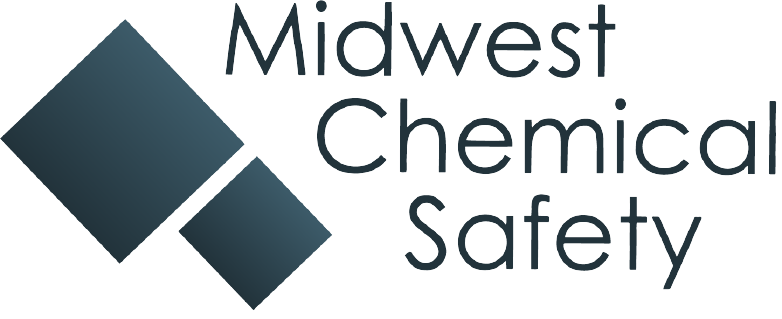This is Part Four in Midwest Chemical Safety’s series on Leadership in Environmental Health and Safety. Catch up on the series in sequential order here:
Part One: Leaders- Not Managers in EHS Leadership
Part Two: Giving Information in EHS Leadership
Part Three: Understanding Group Needs in EHS Leadership
Developing Capability

Teams exist for an overarching purpose: to assist their parent organization to accomplish its mission. Specifically, environmental, health, and safety (EHS) groups exist to assist the parent organization or company in protecting people and the environment from insult that may occur during the company’s work. While broadly stated, there are numerous regulations, standards, and best practices that are utilized to accomplish the purpose. Competencies which leaders need to master to accomplish the team’s purpose include:
- Setting the example
- Controlling the group
- Representation of the group
- Problem-solving
- Evaluating
Setting the Example
Two competencies reign supreme in leaders. The first we have already identified – communication (Getting and Giving Information). The second is equally important: Setting the Example.
Setting the example is your behavior apart from outside influences. Maintaining the example, especially under difficult circumstances, is vital for success. Likewise, failing to set the example for your team will doom the team to failure. If you do not match your speech with your actions, you will quickly lose the respect of your team and find it impossible to get anything accomplished. Ask yourself, “If I fail to set the example, why should anyone else on the team do better?” Everything you do and say should line up with the best examples possible. The best and most effective way to influence team members is to set the example of the behavior you expect from them.
Here are a few key behaviors by which leaders set the example for their team:
- Commitment to the goal: Once a path is chosen, you exhibit both persistence and consistency to the plan.
- Commitment to the team: Work hard at making the team look good. When they look good, you look good as well.
- Show initiative: Anticipate the needs of the group and the project, and act on them without being prompted. Solve little challenges before they become big problems and look for opportunities along the way.
- Know your job: Leaders keep the “big picture” in mind as well as the details. You must know what is expected of you by both those who you lead and those to whom you report. Be proficient in the skills of your team. For example, if you lead a group of industrial hygienists or occupational safety professionals, be proficient in the common skills associated with those professions and, if necessary, seek out professional certification.
- Maintaining a positive attitude: There will always be tough times. Likewise, there are good times as well. Leaders rise above those “bad times” by knowing circumstances are in constant change. Admiral James Stockdale, a Viet Nam Prisoner of War and resident of the “Hanoi Hilton” summed up the importance of maintaining a positive attitude regardless of the circumstances: “You must never confuse faith that you will prevail in the end – which you can never afford to lose – with the discipline to confront the most brutal facts of your current reality, whatever they might be.”
If you find yourself in a situation where you are in the beginning stages of forming a team, I urge you to surround yourself with people who are better and brighter than you are. I was once told that “A-Leaders hire A-people. B-Leaders hire C/D-people” and have found this a powerful aphorism that consistently plays out in business.
Controlling the Group
By way of analogy, if the team is an engine, facilitating group behavior is the throttle on that engine. Leaders must carefully balance the goal that the group is working towards against keeping the group happy, satisfied, and motivated.
While sometimes colloquially called “herding the cats,” group facilitation is probably the second most noted competency by those outside the group. It is the leader’s ability to keep the team on track and moving in the same direction to accomplish the team’s goals. Leaders adept at group facilitation will find that they have less re-work in the group’s projects (e.g., fewer mistakes and mistakes caught early) and that tasks will be accomplished more quickly.
It’s important that you take the time to observe your team in action and provide them feedback during work and when tasks are completed. Praise a job well-done. Watch for those that may need assistance and talk with them privately. In large group tasks, if you believe the group is headed in the wrong direction, have them take a break and have them evaluate their work together.

What About Meetings?
During the 2020 COVID pandemic, for better or for worse, many businesses pivoted to online platforms for meetings that were once held face-to-face at the office. I saw many of these meetings “go off the rails” because the meeting organizer (or meeting “facilitator”) did not have the skills to keep people on topic and task. There are a few good tactics to keep the group focused on the topic at hand:
- Boomerang question/concern: Turn the question or concern around back to the group and ask what the group thinks about it.
- “What’s the real issue?” This simple question can get the group back on track quickly by getting them off tangents that will always come up during open discussions.
- Set and enforce ground rules. Simple rules such as “one person speaking at a time” are vital for effective communication, especially in a virtual environment. Virtual meetings inherently have a latency associated with them that face-to-face meetings do not, due to the technology platforms used by the participants. For example, my home office uses a satellite internet connection where latency can be 0.5-1.5 seconds, making it easy to step on each other during conversation. One comment about ground rules for meetings: Everyone in the meeting needs to know them and agree to them before they can be effectively enforced.
- Frequently check for agreement and understanding among the participants.
- Encourage everyone to participate in the meeting.
Some final thoughts on group facilitation: give praise for total team effort, especially for those responsible for above-and-beyond performance, correct individual errors afterwards and away from the group.
Representing the Group
This competency is the first skill that acknowledges other groups or teams in the organization. Eventually, the time will come when you need to represent your team’s ideas and work to others. Sometimes the representation will be to your peers, while other times, you will be representing your team to upper-level leadership or management. Representation is the process by which others, outside the team, will come to know your group. While communication is a factor, it is not the only factor involved in group representation.
As a team leader, you are a conduit for information both from your team and to your team with respect to other teams in the overall organization or senior leadership. You are in the middle. You are called upon to faithfully represent ideas and thoughts to others depending on the direction of the communication to or from your team. As your team’s leader, you have a tremendous amount of responsibility associated with this competency: other groups, both internal and external to your organization, will derive their opinions of your team based on your representation.
Decisions, Decisions
If you represent a decision that the group has made to others, fully understand both the nature of the question being answered/challenge being solved by that decision and how the decision was reached. Ascertain the group’s commitment to the decision as well. Remember, however, as a representative of the team, once the team has decided, you are committed to it even if you think differently. Your time to voice your personal opinions has passed – you are now the voice of the team.
There will also be times when you will be called on to make a decision for the team without having a chance to seek their opinion beforehand. This will be uncomfortable. These decisions will be easier (not necessarily comfortable) if you have cultivated a high degree of trust within your team. Consider the following before making these “on-the-spot” decisions:
- Do you have any precedents or similar situations on which to rely?
- How much trust does the team have in you?
- Has the team empowered you to act on your own using your own judgement? (This is also a trust issue.)
- What are the short-term and long-term effects of the decision?
- Can the decision be deferred for a short time to consult your team? If the decision has a high impact for the team or for the larger organization, you should insist on deferring the decision to consult your team.
Delegating Representation Duties
Remember, as the team leader you are responsible and accountable for all team decisions, including how your team is represented to others. You can delegate the duties associated with representing the team to others, but, ultimately, all representation will fall on your shoulders. You may choose to delegate issues that are not critical to the team’s success to others on the team so that they can build their skills in communication and representation.
Developing Capability will be continued next week when we discuss the final two skills in this set, Problem Solving and Evaluation.
Want to take your EHS Team to “Best in Class” but don’t quite know where to start? Call Midwest Chemical Safety, LLC, 217-971-6047 or contact me by email at harry@midwestchemsafety.com. See the original LinkedIn Post Here.

